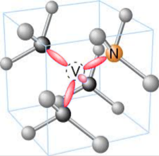Zack Jones, a graduate student in the Center for Sustainable Nanotechnology, gives diamonds to his study organism. But they're nanodiamonds, not jewelry, and after the tiny worms eat them, Zack uses their fluorescent and magnetic properties to see where the material accumulates within the worm's body. This episode talks about worms, defective diamonds, and how the combination of the two can provide information on environmental contamination.
Zach Jones, a graduate student in the Center for Sustainable Nanotechnology, gives diamonds to his study organism. But they're nanodiamonds, not jewelry, and after the tiny worms eat them, Zack uses their fluorescent and magnetic properties to see where the material accumulates within the worm's body. This episode talks about worms, defective diamonds, and how the combination of the two can provide information on environmental contamination.

Zack Jones (left) and Paige Kinsley (right) recording this episode's interview (photos courtesy of Zack Jones and Paige Kinsley)
Want more podcast episodes? You can find them all on our podcast page, or you can subscribe through Apple Podcasts or Stitcher, or listen on NSF's Science Zone Radio.
ABOUT THIS EPISODE

Diagram of a nanodiamond molecule showing a nitrogen vacancy center defect (missing nitrogen atom) in the middle (image by Zack Jones)
Related links:
Interviewee: Zack Jones
Interviewer: Paige Kinsley
Producer/Host: Miriam Krause
Assistant Producer: Emma Bublitz
Music: PC III and Dexter Britain

This material is based upon work supported by the National Science Foundation under the Center for Sustainable Nanotechnology, grant number CHE-2001611. Any opinions, findings, and conclusions or recommendations expressed on this podcast are those of the participants and do not necessarily reflect the views of the National Science Foundation or the participating institutions.